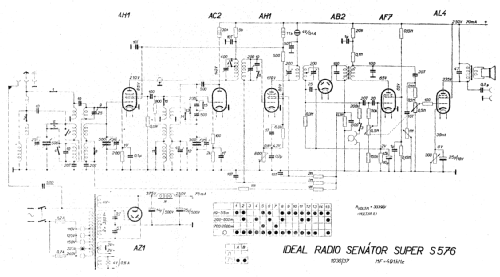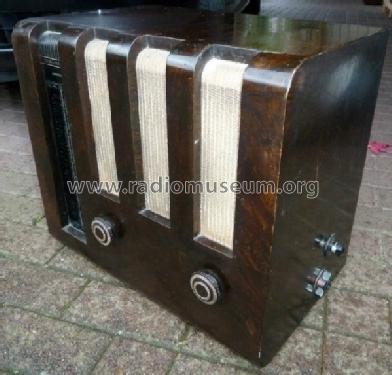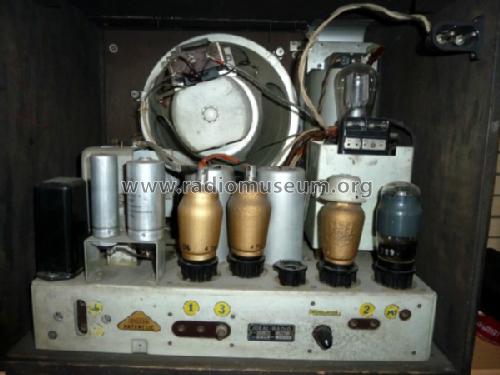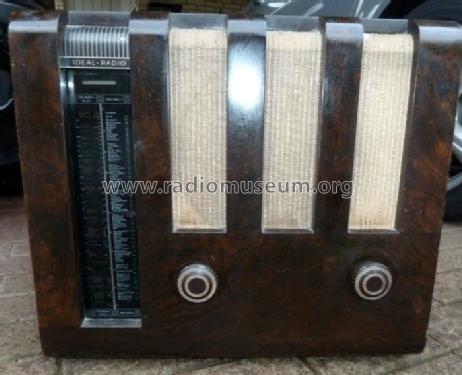Ideal Radio Senator Super S576
Modry Bod, Praha-Kolin
- Country
- Czechoslovakia
- Manufacturer / Brand
- Modry Bod, Praha-Kolin
- Year
- 1936/1937
- Category
- Broadcast Receiver - or past WW2 Tuner
- Radiomuseum.org ID
- 23039
-
- Brand: Ideal-Radio (Blaupunkt CS)
Click on the schematic thumbnail to request the schematic as a free document.
- Number of Tubes
- 7
- Main principle
- Superheterodyne (common); ZF/IF 491 kHz
- Tuned circuits
- 7 AM circuit(s)
- Wave bands
- Broadcast, Long Wave and Short Wave.
- Power type and voltage
- Alternating Current supply (AC) / 110-240 Volt
- Loudspeaker
- Electro Magnetic Dynamic LS (moving-coil with field excitation coil)
- Material
- Wooden case
- from Radiomuseum.org
- Model: Ideal Radio Senator Super S576 - Modry Bod, Praha-Kolin
- Shape
- Tablemodel, with any shape - general.
- Dimensions (WHD)
- 460 x 415 x 296 mm / 18.1 x 16.3 x 11.7 inch
- Notes
- variable Bandbreite; Zeiger-Abstimmhilfe
- Price in first year of sale
- 2,590.00 CSK
- External source of data
- Erb
- Source of data
- Ceskoslovenske prijimace 1933-1945, Baudys 1947
- Other Models
-
Here you find 41 models, 35 with images and 40 with schematics for wireless sets etc. In French: TSF for Télégraphie sans fil.
All listed radios etc. from Modry Bod, Praha-Kolin
Forum contributions about this model: Modry Bod, Praha-: Ideal Radio Senator Super S576
Threads: 1 | Posts: 2
Hallo,
bei der Restaurierung eines Ideal S576 wurde zum Schluss der KW Oszillator zum Problem.
Unterhalb 6,5MHz (Empfangsfrequenz) riss die Oszillatorschwingung ab. Auch bei einer neuen AC2 war kein Erfolg messbar. Langes gelöte, probeweise auswechseln der Bauteile ringsum brachte kein Ergebnis. Die Kontakte des Drehkos reinigen auch nicht.
Die Oszillatorspule ist eine Luftspule auf einer recht großen Papp-Rolle. Diese ist in der Oszillator-Spulenkammer sehr eng eingebaut, mit dicken Drähten. Darum ist es recht problematisch sie auszulöten, ohne andere Bauteile zu beschädigen.
Dann kam ich auf die Idee einen Ferritkern in die Rolle zu legen und siehe da - der Oszillator funktionierte von 5,8 bis 12MHz (Eingangsfrequenz) wunderbar. Ein abgekniffenes Stück einer Ferritantenne wurde eingeklebt und nun ist alles ok.
Die "Originalitätsfanatiker" werden zwar murren, aber der Aufwand zuvor, also um alles andere wieder zu beleben war schon so erheblich, dass es mir langsam zu viel wurde für die KW noch weiter zu forschen.
Übrigens hat das Gerät eine erstaunliche Eingangsempfindlichkeit auf allen Bereichen, trotzdem es keine HF Vorstufe besitzt.
W. H.
Wilfried Haack, 10.Jan.14



